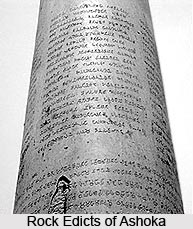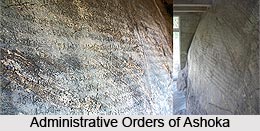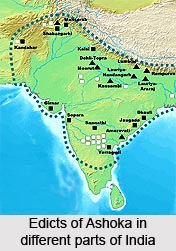 Ashoka was one of the famous rulers of the Mauryan dynasty, under whom the dynasty expanded to its largest magnitude. The structure of Government that was set up by Chandragupta Maurya in order to manage the administration of such a vast Empire was maintained by His son, Bindusara. During Ashoka, expanse of the Mauryan Territory was extended because of his military expedition. To manage the administrative functions of a vast territory, Ashoka introduced several administrative reforms. With the help of such reforms he continued to maintain a centralised administration and at the same time capably managed the provincial administration thereby ensuring social harmony.
Ashoka was one of the famous rulers of the Mauryan dynasty, under whom the dynasty expanded to its largest magnitude. The structure of Government that was set up by Chandragupta Maurya in order to manage the administration of such a vast Empire was maintained by His son, Bindusara. During Ashoka, expanse of the Mauryan Territory was extended because of his military expedition. To manage the administrative functions of a vast territory, Ashoka introduced several administrative reforms. With the help of such reforms he continued to maintain a centralised administration and at the same time capably managed the provincial administration thereby ensuring social harmony.
The structure of the Mauryan Government was a centralised one. Ashoka was at the helm of his administration with his brother Tishya as the deputy. The crown prince and the other kumaras in the sphere of provincial administration also assisted Ashoka. He appointed a group of trusted ministers who always helped him in the matters of administrative policies. Historians have opined that consultation prevailed with the ministers during Ashoka`s reign before adopting any administrative policies and during emergencies. From the Rock Edicts III and VI it is evident that Ashoka continued his grandfather`s practice of consulting the inner ministers or "mantrins" for general and emergency matters. Thus the structure of the central Government during Ashoka, remained more or less unchanged. The only difference was that he had introduced a higher level of philanthropic spirit in his government and administrative policies compared to his mighty grandfather, Chandragupta Maurya.
Ashoka, however did not deviate from the policy of centralisation of his forefathers. Though he granted some autonomy to the Samghas like Brijji, Kambojas and Panchalas, he never let them loose to raise a revolt against the vast Mauryan Empire. Some historians describe Ashoka as a protector of laws and not the propagator of laws, but the Ashokan edicts do not justify this claim. Though he followed the policy of non-violence and benevolence as the king, he amended the criminal laws, whenever he felt it necessary. That is why he also introduced the legal reforms like Danda Samahara and Vyavahara Samahara. Ashoka was the sovereign head of the Mauryan Empire in every inch, as the Arthashastra instructed him to be.
The traditional Mauryan concept of kingship was however softened by the administrative policies adopted by Ashoka because of his paternalist concept. In the Kalinga Edict, Ashoka declared, "All men are my Children". In another Rock edict, Ashoka declared that he was indebted to his subjects and he considered it to be his holy duty to serve the people. Therefore he appointed Pativedakas or reporters, who would report to the king about the general and public affairs for the king to take necessary steps.
Ashoka introduced several reforms in the sphere of provincial administration, which brought about many improvements in the existing system of provincial government. Ashoka retained the traditional administrative divisions of the Empire into provinces or pradesas or districts. These Provinces were again subdivided into Aharas or Vishyas or subdivisions and Janapadas, which were further subdivided into villages. During Ashoka there were only five provinces as the historians have opined. In order to bring the troublesome provinces under full control of the centre and to administer good government to them, he appointed the crowned prince at the head of the provincial government. The crowned prince acting as the provincial governors were responsible for the administrative and general affairs of these provinces. One of the important policies he adopted for the provincial administration was that, Ashoka used to alter the provincial governors from time to time. Moreover Ashoka had appointed many functionaries and dharma Mahamattas and dharma Yutas to cope up with the increasing burden of the missionary work and welfare schemes. In Ashokan regime, Rajukas, Yutas, Pradesikas were entrusted with special assignments in the sphere of provincial administration.
The Mahamattas were invested with the specific departments with specific titles. The Dharma mahamattas appointed by him looked after the material and spiritual well being of the people. The Adhyaksha mahamattas were entrusted with the task of the well being of the women. The Anta mahamattas were appointed for the general administration of the frontier province. The Nagara mahamattas were a class of mahamattas in charge of the cities and towns. They were often engaged in periodical tours in order to collect news about the administrative and general affairs throughout the empire. In Ashoka`s regime, the Mahamattas had become a highly responsible cadre of personnel. The mahamattas in charge of providing justice, were asked by Ashoka to follow the path of Dhamma and to be free from anger, fear and other passions while delivering justice.
From Rock Edict XII, it is evident that there were a group of special officers called Vrajabhumika. Dr Bhandarkar interpreted the term "Vrajabhumika" as the Superintendent of the cow pen. But Dr. R. K Mukherjee interpreted the term "Vraja" as the public utility department. So the Vrajabhumika was a group of public utility department. So according to him Vrajabhumika was a Public Utility Officer supervising the execution of the Ashokan welfare schemes like the construction of roads, digging of wells, planting of shady mangroves etc.
 During the reign of Ashoka, the officials called Rajukas had held a significant place. Ashoka in his administrative policy implemented the Rajukas as the sole agency to execute his plans of reforms. Originally the Rajukas were the officials in charge of measurement of land and settled those if there arose any dispute. Since they were connected with the land revenue department, they normally had a great influence in the rural areas. Ashoka during implementing the administrative policies, enhanced their powers and positions and made them the most important officers of Janapadas. Gradually the Rajukas became the key officers and were entrusted to execute Ashoka`s most welfare projects and administrative reforms. They not only acted as judges with the power to justify wrong sentences and wrong judgments, moreover they made charitable offers to the Sramanas and Bhikshus implemented by Danda Samata and Vyavahara Samata. The function of the Rajukas is enumerated in the Ashokan Pillar edict IV. However Romila Thapar had pointed out that the Rajukas were the junior officers employed in the village areas. But most of the historians have unanimously opined that Ashoka upgraded the status of the Rajukas.
During the reign of Ashoka, the officials called Rajukas had held a significant place. Ashoka in his administrative policy implemented the Rajukas as the sole agency to execute his plans of reforms. Originally the Rajukas were the officials in charge of measurement of land and settled those if there arose any dispute. Since they were connected with the land revenue department, they normally had a great influence in the rural areas. Ashoka during implementing the administrative policies, enhanced their powers and positions and made them the most important officers of Janapadas. Gradually the Rajukas became the key officers and were entrusted to execute Ashoka`s most welfare projects and administrative reforms. They not only acted as judges with the power to justify wrong sentences and wrong judgments, moreover they made charitable offers to the Sramanas and Bhikshus implemented by Danda Samata and Vyavahara Samata. The function of the Rajukas is enumerated in the Ashokan Pillar edict IV. However Romila Thapar had pointed out that the Rajukas were the junior officers employed in the village areas. But most of the historians have unanimously opined that Ashoka upgraded the status of the Rajukas.
In the sphere of justice and civic life, Ashoka introduced many reforms because of his humanitarian and paternal sentiment. He introduced the officials in order to execute justice properly and to preach the principles of Dhamma. Moreover there were special groups of officials in order to organise charities, promote toleration and reduce the burden of punishment of the criminals. Ashoka released the prisoners from jail on the anniversary of his coronation. The principles of uniformity of penalty and uniformity of judicial procedures were enforced. Moreover during implementing administrative policies, Ashoka tried to promote the spiritual welfare of his subjects by preaching dharma and by inculcating toleration among his subjects, he aspired to have a social harmony. At the same time he issued ordinances prohibiting animal sacrifices and injury to animals and initiated welfare programmes for the well being of the subjects.
Such a planned and balanced structure of Government with effective administrative reforms, had established the Mauryan Empire under Ashoka as one of the supreme powerful empires in India. During his time, the Mauryan Empire experienced a fair civic and social life and was free of any sectarian revolt and internal chaos and anarchy. Owing to his effective administration, Ashoka is often considered as one of the greatest monarchs of India.



















